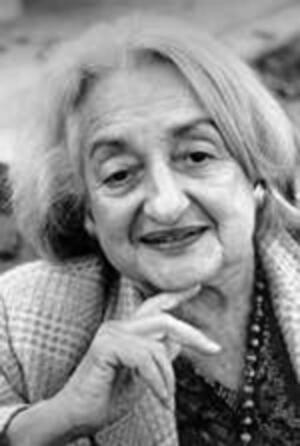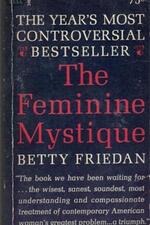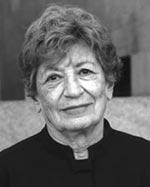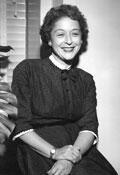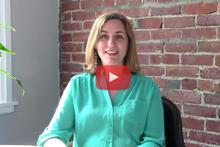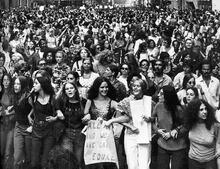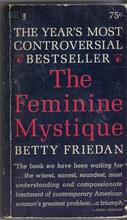Betty Friedan
Born Bettye Naomi Goldstein, feminist revolutionary Betty Friedan (1921–2006) was considered by many to be the "mother" of the second wave of modern feminism. Her struggles against the "Feminine Mystique" and in favor of gender equality led to a fundamental transformation, not only in the way American society views women, but in the way American women view themselves.
Institution: Online repository.
Betty Friedan was a labor activist who had to stop work with the birth of her second child. Unhappy as a housewife and mother, she analyzed the condition of women like herself. Her research formed the basis of her pathbreaking feminist book, The Feminine Mystique, which sold millions of copies and helped provoke a feminist movement in the United States. An activist and writer, she co-founded the National Organization for Women and other women’s political groups and led NOW for some years, but she also criticized the direction that the women’s movement took. As a secular Jew, she grew interested in Zionism and in the rights of women in Israel. Her many books and articles focused on women’s rights and the women’s movement.
Considered by many as the “mother” of the second wave of modern feminism, activist and writer Betty Friedan was one of the most influential feminist leaders of the second half of the twentieth century. A co-founder of the National Organization for Women (NOW) and its first president, she also served on the boards of leading women’s organizations, fought for legislation to ensure women’s equality, and wrote books analyzing women’s role in society and the women’s movement.
Early Life & Education
Bettye Naomi Goldstein was born on February 4, 1921, in Peoria, Illinois. Her father, Harry Goldstein, an immigrant from Russia, owned a jewelry store. Her mother, Miriam (Horwitz) Goldstein, gave up her position as editor of the women’s page of the local paper to raise her family. Bettye attended Smith College, majoring in psychology and editing the college newspaper. Under her stewardship, the paper supported the fight against fascism abroad and union organizing at home. She graduated summa cum laude in 1942.
Betty, who dropped what she thought the pretentious “e” at the end of her given name, became a psychology research fellow at the University of California in Berkeley for a year after graduation. Then she moved to New York, where she involved herself in labor union activity, writing for labor union publications. She worked for one of the most radical unions in the postwar era, the UE or United Electrical, Radio and Machine Workers of America. Her experiences as an activist in the labor unions of the 1940s and early ‘50s spurred her interest in working women’s issues.
In 1947, she married Carl Friedan (the name they changed from Friedman at the time of their marriage), a summer-stock producer who later worked as an advertising executive. They had three children in a marriage that lasted twenty-two years. Friedan continued working after her first child’s birth in 1949 and received maternity leave. She was forced to leave her job during her second pregnancy in 1953 and spent the next decade raising her two sons and a daughter. She continued to write, this time for middle-class women’s magazines.
The Feminine Mystique
In 1957, Friedan surveyed two hundred of her Smith College classmates and found that many of them suffered from “the problem that has no name.” They were supposed to be happy in their suburban paradises, with working husband and smiling children, but many were bored, depressed, and anxious. She delved further, not satisfied by the women’s explanations that they caused their own unhappiness. She received widespread responses to an article she published in Good Housekeeping (September 1960) entitled “Women Are People Too!” and realized that the malaise she found extended beyond women from prestigious eastern colleges.
Her inquiries resulted in The Feminine Mystique, which both labeled the resurgent domestic ideology of the postwar era and exposed those who perpetuated it: women’s magazines, advertising experts, Freudian psychologists, social scientists, and educators. Her critique of the romanticizing of domesticity led to a feminist explosion, launching the sex-role revolution. An immediate best-seller in 1963, the book made Friedan a celebrity. It has sold well over three million copies, has been translated into a dozen languages, and still sells thousands of copies a year. In 1976, a New York literary club included it, along with works by Galileo, Marx, and Mao Zedong, in its exhibit “Books as Troublemakers,” about books that stirred millions of people and changed lives. Despite its popularity, the book caused Friedan personal troubles. Her children were ostracized from car pools, and friends rebuffed her and her husband. She realized that she was too threatening to other mothers who had not yet come to terms with their own lives.
In The Feminine Mystique, Friedan described a depression that afflicted many middle-aged, college-educated women, and she suggested its cause. She argued that the media and educators had created an image of women’s proper role as appendages of their husbands and children: “as Tom’s wife or Mary’s mother.” This “feminine mystique” insisted that women deny their own desires for the sake of familial harmony. Their lack of excitement about their own lives made them smother their children and cling to their husbands. Thus, on a familial level, they were bored and ineffectual.
On a societal level, the result stifled women’s growth, wasted massive human potential, and caused immense dissatisfaction among women, as well as among their families. At a time when more and more women were entering the workplace as working mothers, Friedan argued that women should not accept their inferior status at home or in the work force. By accepting limitations in their public roles, they would also fail in their private roles. She called for women’s self-assertion, for women’s equality in the workplace and in the home. By defining women’s problems as broad and structural rather than personal, she has been credited with getting women to understand their position in society.
Activism: Organizing and Writing

Marchers with the Olympic torch at the National Women's Conference, (left to right) Billy Jean King, Susan B. Anthony II, Bella Abzug, Sylvia Ortiz, Peggy Kokernot, Michele Cearcy, Betty Friedan, 1977.
Copyright © Diana Mara Henry / dianamarahenry.com
Friedan went on to co-found NOW, originally a gathering of three hundred women and men, mainly professionals, in 1966. She served as its first president until 1970. NOW’s statement of purpose attacked “the traditional assumption that a woman has to choose between marriage and motherhood on the one hand and serious participation in industry or the professions on the other.” It sought an end to job discrimination through legislation, education, and court action. It also lobbied for paid maternity leave, the establishment of child care facilities, and the legalization of abortion. NOW also supported the Equal Rights Amendment to the Constitution that would prohibit discrimination on the basis of sex. Friedan declined to run for president of NOW in 1970 due to her feeling that the organization’s rejection of men as members and its insistence on equal rights for lesbians was too radical.
Friedan continued to write and lecture on the subject of women’s equality while she taught at New York University and the New School for Social Research. She divorced in 1969, the year she helped found the National Abortion Rights Action League. In 1970, she organized a nationwide Women’s Strike for Equality in which forty to fifty thousand women marched down Fifth Avenue in New York City to show that the women’s movement had a broad and powerful base. A year later, together with Bella Abzug and Shirley Chisholm, she convened the National Women’s Political Caucus (NWPC). With the motto, “Make policy, not coffee,” she hoped to galvanize women into running for office, to get women elected to office, and to get them seated as delegates in the national conventions. Moreover, the NWPC rallied support for the Equal Rights Amendment. Friedan insisted that women should have a voice in the political process. All along, she advocated women’s rights within the Democratic Party and played a role in getting the Democratic Party to give women half its delegate strength in 1976. She participated as delegate in 1984, when the Democrats nominated Geraldine Ferraro for vice president.
In 1975, the American Humanist Association nominated Friedan “Humanist of the Year” and she received an honorary doctorate of humane letters from her alma mater, Smith College. The Girl Scouts also elected her to their national board. Thereafter she received numerous honorary doctorates of humane letters and law. In 1976, she published It Changed My Life. By that time, her message had appeared in such diverse publications as the New York Times Magazine, Woman’s Day, Redbook, The New Republic, Ladies’ Home Journal, Harper’s, Social Policy, Cosmopolitan, Family Circle and McCall’s, where she had a regular column in the early 1970s entitled “Betty Friedan’s Notebook.”
It Changed My Life: Writings on the Women’s Movement, a collection of her previous essays, talks, and some of her McCall’s columns, included additional comments bringing these earlier works up to date. Here she voiced her concerns with the direction the women’s movement seemed to be taking and described some of the disputes within its leadership. She worried that sexual politics, including issues of sexuality, lesbianism, and “random hatred of men,” would be “highly dangerous and diversionary,” and that “no serious meaningful action emerges from a sexual emphasis. There is simply talk [and] anger.”
She feared such “wallowing” would alienate “everywoman,” and would detract from real action in offices, classrooms, and political arenas. Although she admitted to the validity of the statement, “If they succeed in scaring us with words like ‘dyke’ … they’ll have won. AGAIN. They’ll have divided us. AGAIN,” she responded: “Lesbian rights as one issue among many on the agenda of the women’s movement is one thing—lesbian rights as the main issue, the hallmark, is something else. … As an expression of sexual preference, to each her own. But as a political statement, it’s a copout.”
Her book The Second Stage was developed while teaching as a visiting professor of sociology at Temple University, Yale University, the New School, and Queens College of the City University of New York. In this book, Friedan recognized the powerful forces aligned against feminism, but she focused on how the movement itself had gone astray. She defined the “first stage” of feminism as women’s “full participation” or “power and voice in the mainstream” (inside the party, the political process, the professions, and the business world); recognition of women’s personhood; and women’s control over their own bodies (what she called a “woman’s right to choose motherhood in dignified, supportive circumstances”).
It was time, she argued, for the women’s movement to enter its “second stage,” a coming to “new terms with the family—new terms with love and with work.” She maintained that women, “helped by men,” needed to transcend the battle for equal power within institutions. They needed to restructure the institutions themselves, while simultaneously transforming the nature of power. She demanded child care programs, parental leave, and flexible work hours, and insisted that she was not for abortion, but for the choice to have children.
She voiced her ongoing discomfort with new feminist ideologies, argued for more balance within the women’s movement itself, and blamed radical elements in the movement who, she thought, being distracted by sexual politics (whether around issues of pornography or lesbian rights), ignored the real needs of most women for family and nurturing. She insisted that for the founding mothers of the women’s movement “equality and the personhood of women never meant destruction of the family, repudiation of marriage and motherhood, or implacable sexual war with men.” She wrote that the women’s movement did “not fail in the battle for equality. Our failure was our blind spot about the family.” In fact, she worried that a new “feminist mystique” would keep women out of the home, repudiating the family and alienating young women who hoped to balance public lives with domesticity and motherhood.
Friedan was criticized by many feminists for this book, which some felt erased race issues and sexual complexities while blaming the victims, women. Although Friedan had made more public, supportive statements about lesbians since 1977, the book failed to see, wrote Catherine Stimpson in a 1981 Ms. article, “how queer bashing is the Red baiting of this decade.” Friedan wanted lesbianism in a private, not public place, “brushing it all back into the closet.” Friedan did not change her mind, however: “The recent leadership [of NOW] did not like my book,” she said in an interview. “I was right. And I was addressing it at them.”
Jewish Issues
Friedan’s interest in Jewish issues had started at home in Peoria, where she had felt isolated as a result of antisemitism, and also at Smith College, where she noticed that some classmates preferred to hide their Jewish heritage. Never a religious person, she pointed to antisemitism as alerting her to social injustice of all sorts. By the 1970s, she had reconnected with Judaism by studying Jewish texts and working with the American Jewish Congress (AJC) as co-chair of its National Commission on Women’s Equality. Yet she expressed misgivings about Israeli hostility towards feminism in those years and about American Jewish male leaders who seemed threatened by feminism.
In 1975, 1980, and 1985, Friedan attended the International Women’s Conferences sponsored by the United Nations and grew deeply upset when the first two conferences equated Zionism with racism. Indeed, in November 1975, a day after the United Nations similarly coupled Zionism with racism, she publicly declared herself a Zionist. She also worried about antisemitism in the U.S. and international women’s movements. In 1984 she headed a delegation of American Jewish women who participated in a U.S./Israel dialogue, entitled “Women as Jews, Jews as Women.” Organized by the American Jewish Congress (AJC), the dialogue led directly to the founding of the Israel Women’s Network, largely as a result of Friedan’s impassioned call on Jewish women to “put your bodies where your mouths are.”
On Aging
In 1988, Friedan became a distinguished visiting professor at the University of Southern California’s journalism school and its Institute for the Study of Women and Men. She was also a visiting professor at New York University and did research for her next book on aging at the Center for Social Science at Columbia University, the Center for Population Research at Harvard University, and the Andrus Gerontology Center at the University of Southern California. Her Fountain of Age, published in 1993, defined and decried the “age mystique,” much as Friedan’s first book had attacked the feminine mystique. The age mystique is one in which age “is perceived only as decline or deterioration from youth,” and its victims are “rendered helpless, childlike and deprived of human identity or activities,” so that they “don’t remind us of ourselves.”
In this book, she admitted to her own denial and fear of age as she attempted to overturn the tendency of experts to treat age only in terms of pathology. Instead, she saw aging as yet another stage for growth, a time for “new qualities and strengths” to emerge. She used her feminist analysis to ask whether, as women’s definition of themselves changed from their biological role (as mothers and sexual partners to men) to asserting their full personhood (via feminism), their aging changed too. Simultaneously, she worried about younger women “dressed for success,” living and dying “like men.” She wondered whether the larger perspectives of women could “change the very biology of the aging process.”
Friedan noticed that the polarization between men and women, between the “masculine” and “feminine” sides of personalities, softened in aging. Women, however, made the transition more easily, which may explain, in part, why they live longer. For herself, aging meant her “liberation from the power politics of the women’s movement.” She “recognized my own compelling need now to transcend the war between the sexes, the no-win battles of women as a whole sex, oppressed victims, against men as a whole sex, the oppressors. … The unexpectedness of this new quest has been my adventure into age.”
Friedan continued to write and fight. She remained anxious that recession and sexual backlash would increase polarization and create a new feminine mystique. Specifically, she feared that economic bad times would scapegoat women, that “downsizing” industries might send women back home “where they belong” to raise children. She saw the portents of this in short skirts and high heels; in the 1986 Yale-Harvard study interpreted to imply that if women did not marry before age thirty they would have a better chance of being killed by a terrorist than of finding a mate; in the “self-help” books showing women how to “get their man”; and in the many films in which women are put in “their place.” In fact, she argued that women’s image in the media was more and more divergent from the truth, a “blind spot—a symbolic annihilation” of gains women had really made. She urged the women’s movement to fight for a whole “domestic agenda”: child care, health care, housing, jobs. Finally, she continued to insist that women should fight next to men. It should not be feminism against men or feminism against the family: “We need a new political movement of women and men toward a new society.”
Betty Friedan died of congestive heart failure at her home in Washington, DC, on her eighty-fifth birthday, February 4, 2006. She left behind two sons—Daniel, a theoretical physicist of Princeton, New Jersey, and Jonathan, a mechanical engineer, of Philadelphia, Pennsylvania—and a daughter, Emily, a pediatrician, of Buffalo, New York.
Selected Works by Betty Friedan
The Feminine Mystique. Intro. By Anna Quindlen. New York: W.W. Nortan & Company, 2001. First published 1963.
It Changed My Life. New York: Random House, 1976.
The Second Stage. Summit Books, 1981.
The Fountain of Age. New York: Simon & Schuster, 1993.
Life So Far: A Memoir. New York: Simon & Schuster, 2000.
American Social Leaders.
Antler, Joyce. "Betty Friedan, Feminism, and Jewish Identity." In Antler, The Journey Home: How Jewish Women Shaped Modern America. Jewish Women's Archive (Viewed on April 3, 2019).
Antler, Joyce. Jewish Radical Feminism: Voices from the Women's Liberation Movement. New York: New York University Press, 2018.
Bohannon, Lisa Frederikson. Women’s Work: The Story of Betty Friedan. Greensboro, North Carolina: 2004.
Eisenstein, Zillah. “Friedan’s Liberal ‘Feminist Mystique’ and the Changing Politics of NOW.” In Zillah R. Eisenstein, ed., The Radical Future of Liberal Feminism. New York: Longman, 1981.
EJ (1983–1985).
Encyclopedia of American Biography.
Hennessee, Judith. Betty Friedan: Her Life. New York: Random House, 1999.
Horowitz, Daniel. Betty Friedan and the Making of The Feminine Mystique: The American Left, the Cold War, and Modern Feminism. Amherst, MA: University of Massachusetts Press, 2000.
Horowitz, Daniel. https://www.c-span.org/video/?115125-1/betty-friedan-feminine-mystique. (Viewed on April 3, 2019).
Life 11 (February 1988): 96–98.
Los Angeles Times, February 24, 1992, E, 2:2.
See a short video clip with Betty Friedan and about The Feminine Mystique from the “MAKERS: Women who Make America” project.

